The noise is part spaceship, part jet engine and part Tron bike, according to Alex Tai, the head of Virgin’s Formula E racing team. The high-powered, all-electric cars zooming around the Donington Park race track are certainly far quieter than the chest-rumbling, ear-splitting noise that hits Formula One fans.
But the new Formula E championship is breaking a host of racing taboos: special music to trumpet crashes, female drivers, city centre circuits and, most controversially, a fan vote to give the most popular drivers power boosts to blast them past opponents during races. Nonetheless, racing royalty from Alain Prost to Sir Frank Williams are backing the new series, with Emerson Fittipaldi declaring it a “new era for motor racing”. It has now been approved by world motor sport’s governing body, the FIA, and is funded by stars including Leonardo DiCaprio and major carmakers including Audi, Renault and Indian giant Mahindra.
“There is a need for motor sport to be relevant,” says Formula E chief executive, Alejandro Agag, at the Donington trackside during the first public testing sessions last week. He claims lofty ambitions for the zero-emission race series: to make electric cars sexy, accelerate improvements in the technology and tackle city-choking air pollution and, ultimately, climate change. Agag, like most of those involved, have roots in Formula One and are reluctant to criticise the brash, gas-guzzling F1 circus seen by some as an eco-horror show.
But Tai, who also worked on the Virgin Galactic space rocket programme, is not. “We thought we could influence F1 from the inside [to become much greener and cap the vast amounts of money spent],” he says. “But we couldn’t, so we exited. Racing with chequebooks was obscene.” Even four-time F1 champion Prost, now running his own Renault-backed Formula E team, accepts the petrol-head F1 fans have not warmed to rule changes enforcing better fuel efficiency: “I would not say at all that Formula One is the past, but I am a bit disappointed that the perception the fans have of the new [F1] technology is not what it should be, because it is fantastic.”
The 10-race Formula E series begins on the streets of Beijing in September, with other cities including Berlin, Buenos Aires, Los Angeles and finally London in June 2015. Ten two-car teams will compete in the hour-long races, with drivers changing cars rather than batteries during the single pit stop. The charging generators will be powered by renewable fuel.
The drivers, including F1 stars like Jarno Trulli, say the cars feel like regular Formula One cars. They have top speeds of 225kph (140mph) – slower than the 350kph F1 reaches – but Prost argues speed is not the key to entertainment. “If you have been a racing driver, you know you can race and have fun with any kind of car,” he says.
The most controversial feature is the “fan boost”, where the three drivers amassing the most social media votes get a 2.5 second burst that increases the power of their car by 50% and which the drivers call “push to pass”. Agag says complaints that this interferes with the racing misses the point: “If it doesn’t interfere what would be the point of the fans voting? But we will take care to make sure the effect is not too big. If you’re last you’re not going to win the race with fan boost, but if you’re second you may win at the end.”
He says fan boost and running the races in city centres - “the natural environment for electric cars” - are both aimed at attracting new and younger people - those who know more about an Xbox than a petrol engine. Prost agrees: “In Formula One it is difficult to attract younger people today.”
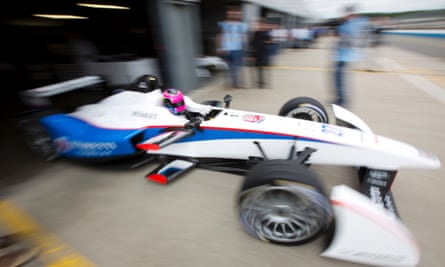
Also controversial is the 80 decibel (dB) noise, louder than a road car but far quieter than an F1 car which produces a 130dB roar. “One of the parts of motor sport is big engines, big noise, the smell of motor fuel, so there is a part of motor sport [that] is not here, for sure, but that is the direction the world is taking, not just in motor sport,” says Michela Cerruti, from the Trulli team and one of two women drivers already signed up to Formula E.
The relative quiet means specially composed music can accompany the races, with signature tunes for key events like the start and finish, overtaking, fan boosts and even crashes. “Crashes are a part of motor sport,” says Agag. “But the music will be more sad for them.” The low noise also means city-centre racing is possible, increasing the tension, says Sam Bird, one of Virgin Racing’s drivers. “The difference between a street circuit and conventional circuit is, if you make a mistake, you are in the barrier, not in a gravel trap or spinning onto extra tarmac.”
In the first year, the drivers will all have the same car, created by Spark, McLaren, Williams and Renault. After that teams will be able to make their own improvements. But tight rules mean this has to focus on the battery and drive train, the areas with the most relevance for road cars rather than, for example, the aerodynamic shape which F1 teams spend millions on improving. This also means the cost of running a Formula E team is likely to be about £3m rather than the £200m for an F1 team.
Bird says the key to winning Formula E will be managing the battery: “The driver that can make the battery last whilst being fast will be the guy or girl at the front at the end. We will have to think very strategically. But having “push to pass” means it is also definitely going to be easier to overtake.”
The sales of electric road cars have been much lower than early expectations, due to short ranges, cost and being seen as uncool. Steven Lu, CEO of the China Racing Formula E team, says: “It is very important to get more electric cars on the streets of Chinese cities. Beijing went from having 800,000 to 6.5m cars in 10 years and there is a lot of pollution in China and in cities around the world. The problem for electric cars in China is that people think the safety, reliability and range is not so good. But people will think that if they can race, they are safe.”
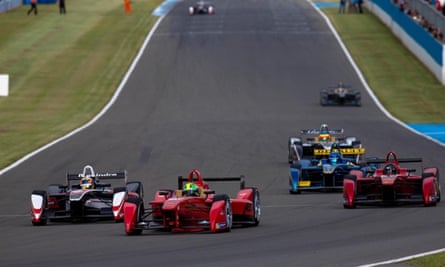
Whether Formula E can make electric cars cool and provide a guilt-free thrill for eco-conscious race fans remains to be seen. “I don’t know if it will be the future of motor sport, but it is a big change,” says Prost. “People do not like change, but sometimes you have to change, even if it is not so good at the beginning.”
In the end, the fans will decide and the dozen or so interviewed by the Guardian at Donington - Formula E’s first public outing - were all positive. “Before I came here today, I slagged it off a bit, but I think this has a chance,” said student Anil Parmar. F1 had burned itself out and was too aloof, said others.
“These look alright to be fair,” said motor sport fan Robert Gossage. “It is the way forward, you just have to get used to it.” But asked whether it would make him more likely to buy an electric car, he replied: “Not anytime soon.”
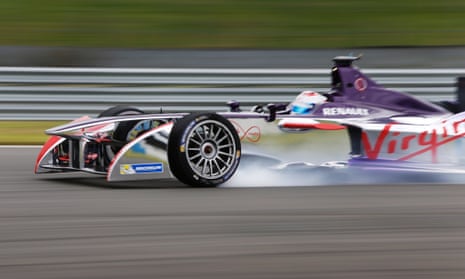
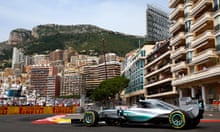


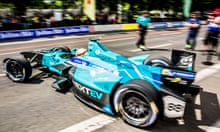



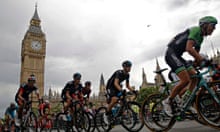
Comments (…)
Sign in or create your Guardian account to join the discussion